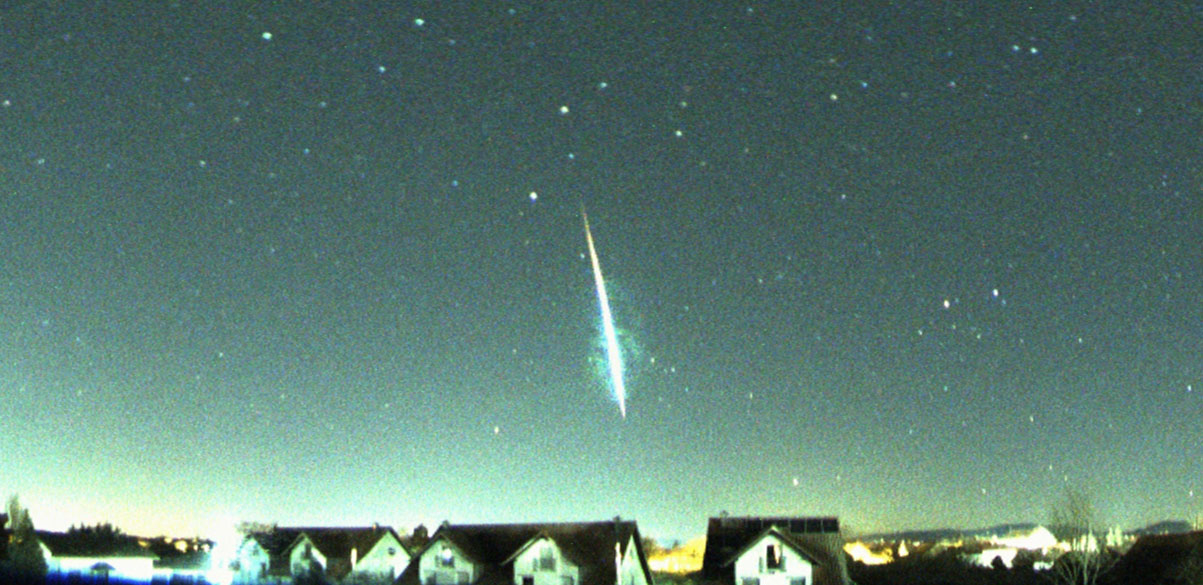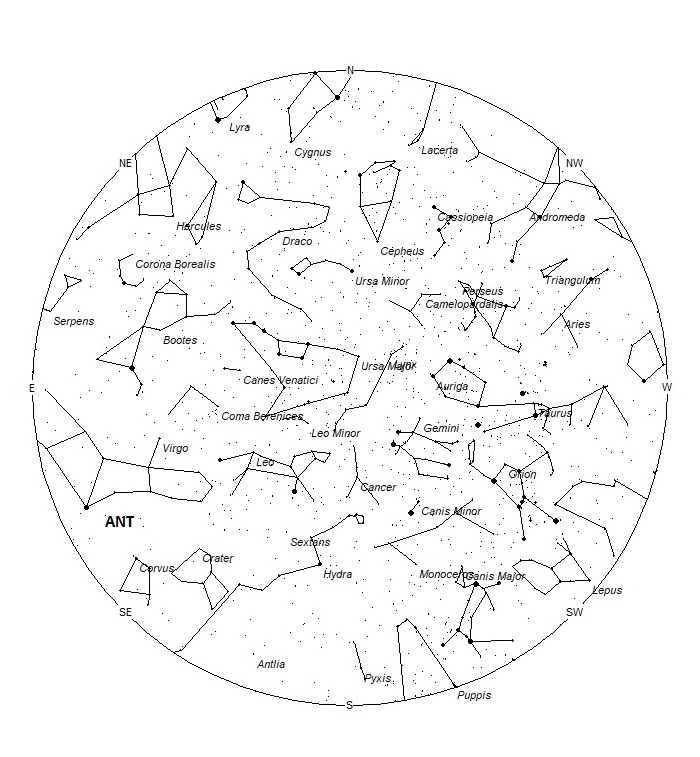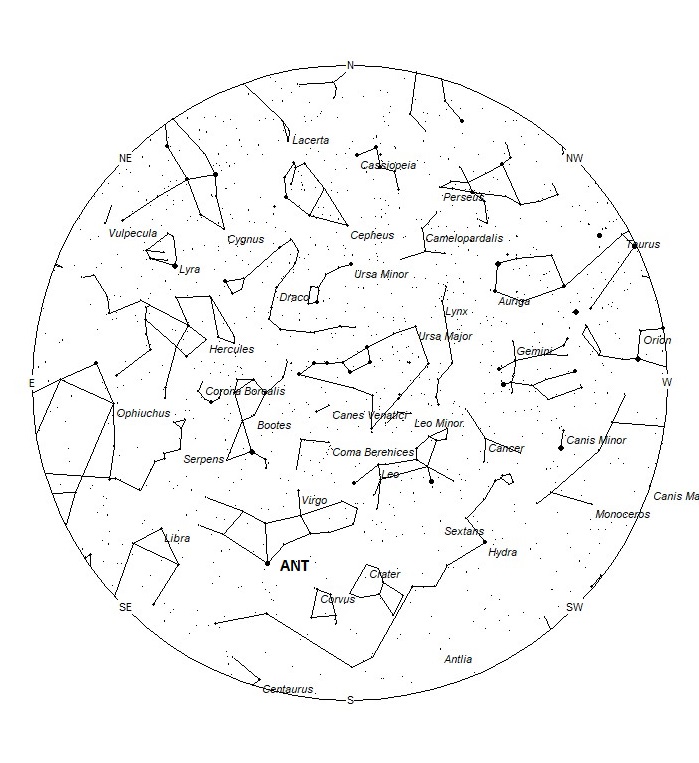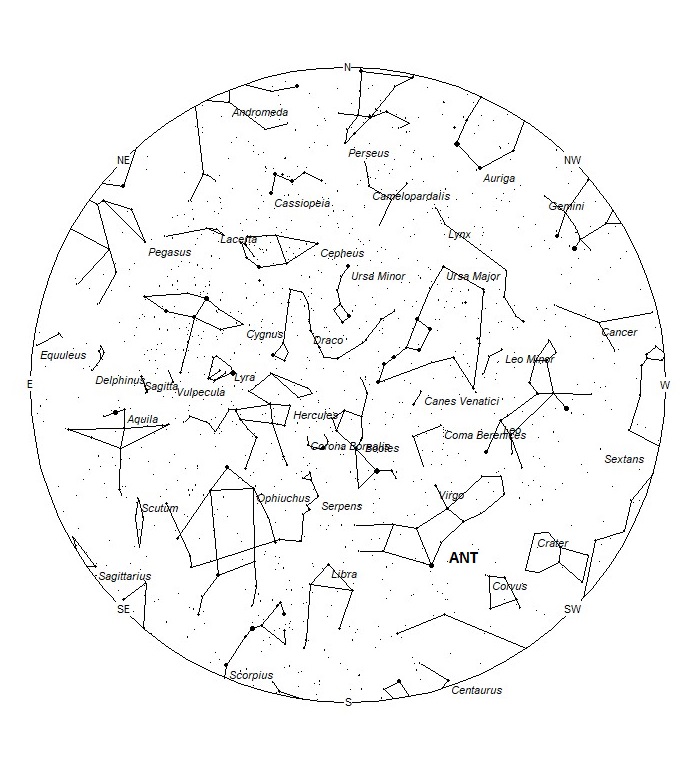 Mario Braun captured this bright fireball with a persistent train just above the horizon from Bornheim, Germany, on 6 March 2021, at 02:46 CET (1:46 UT). For more reports on this fireball, visit: https://fireball.amsmeteors.org/members/imo_view/event/2021/1341 Credit Mario Braun.
Mario Braun captured this bright fireball with a persistent train just above the horizon from Bornheim, Germany, on 6 March 2021, at 02:46 CET (1:46 UT). For more reports on this fireball, visit: https://fireball.amsmeteors.org/members/imo_view/event/2021/1341 Credit Mario Braun.During this period the moon reaches its first quarter phase on Sunday March 21st. On this date the moon is located 90 degrees east of the sun and sets near 02:00 local standard time (LST). As the week progresses the moon will start to interfere with the more active hours of the morning sky, especially toward dawn. The estimated total hourly meteor rates for evening observers this week is near 2 as seen from mid-northern latitudes and 4 as seen from tropical southern locations (25S). For morning observers, the estimated total hourly rates should be near 5 as seen from mid-northern latitudes (45N) and 11 as seen from tropical southern locations (25S). Evening rates are reduced due to moonlight during this period. The actual rates will also depend on factors such as personal light and motion perception, local weather conditions, alertness, and experience in watching meteor activity. Note that the hourly rates listed below are estimates as viewed from dark sky sites away from urban light sources. Observers viewing from urban areas will see less activity as only the brighter meteors will be visible from such locations.
The radiant (the area of the sky where meteors appear to shoot from) positions and rates listed below are exact for Saturday night/Sunday morning March 20/21. These positions do not change greatly day to day so the listed coordinates may be used during this entire period. Most star atlases (available at science stores and planetariums) will provide maps with grid lines of the celestial coordinates so that you may find out exactly where these positions are located in the sky. A planisphere or computer planetarium program is also useful in showing the sky at any time of night on any date of the year. Activity from each radiant is best seen when it is positioned highest in the sky, either due north or south along the meridian, depending on your latitude. It must be remembered that meteor activity is rarely seen at the radiant position. Rather they shoot outwards from the radiant, so it is best to center your field of view so that the radiant lies at the edge and not the center. Viewing there will allow you to easily trace the path of each meteor back to the radiant (if it is a shower member) or in another direction if it is sporadic. Meteor activity is not seen from radiants that are located far below the horizon. The positions below are listed in a west to east manner in order of right ascension (celestial longitude). The positions listed first are located further west therefore are accessible earlier in the night while those listed further down the list rise later in the night.
These sources of meteoric activity are expected to be active this week.
.
The center of the large Anthelion (ANT) radiant is currently located at 12:52 (193) -06. This position lies in central Virgo, 3 degrees southeast of the 4th magnitude star known as Zaniah. Due to the large size of this radiant, Anthelion activity may also appear from northern Corvus as well as Virgo. This radiant is best placed near 0100 LST, when it lies on the meridian and is located highest in the sky. Rates at this time should be near 2 per hour no matter your location. With an entry velocity of 30 km/sec., the average Anthelion meteor would be of slow velocity.
The gamma Normids (GNO) are an ill-defined source, only well seen from the Southern Hemisphere. Some sources dispute its existence while others have differing activity periods in March. Here we list the parameters from an article on Meteor showers from the Southern Hemisphere by Sirko Molau and Steve Kerr*. There results show the activity period is from March 22-27 with no distinct maximum. On March 24 the radiant is located at 16:24 (246) -51. This area of the sky lies in eastern Norma, 1 degree south of the 4th magnitude star known as Gamma2 Normae. These meteors are best seen during the last dark hour before dawn, when the radiant lies highest in a dark sky. With an entry velocity of 68km/sec., the average meteor from this source would be of fast velocity. Expected rates are less than 1 per hour. These meteors are poorly seen from the Northern Hemisphere.
As seen from the mid-northern hemisphere (45N) one would expect to see approximately 5 sporadic meteors per hour during the last hour before dawn as seen from rural observing sites. Evening rates would be near 1 per hour. As seen from the tropical southern latitudes (25S), morning rates would be near 8 per hour as seen from rural observing sites and 3 per hour during the evening hours. Locations between these two extremes would see activity between the listed figures. Evening rates are reduced during this period due to moonlight.
*WGN 42-2, Meteor showers of the southern hemisphere, page 25
The list below offers the information from above in tabular form. Rates and positions are exact for Saturday night/Sunday morning except where noted in the shower descriptions.
| SHOWER | DATE OF MAXIMUM ACTIVITY | CELESTIAL POSITION | ENTRY VELOCITY | CULMINATION | HOURLY RATE | CLASS |
| RA (RA in Deg.) DEC | Km/Sec | Local Standard Time | North-South | |||
| Anthelion (ANT) | – | 12:52 (193) -06 | 30 | 01:00 | 2 – 2 | II |
| gamma Normids (GNO) | Mar 24 | 16:24 (246) -51 | 68 | 05:00 | <1 – 1 | IV |







 You saw something bright and fast? Like a huge shooting star? Report it: it may be a fireball.
You saw something bright and fast? Like a huge shooting star? Report it: it may be a fireball.  You counted meteors last night? Share your results with us!
You counted meteors last night? Share your results with us!  You took a photo of a meteor or fireball? You have a screenshot of your cam? Share it with us!
You took a photo of a meteor or fireball? You have a screenshot of your cam? Share it with us!  You caught a meteor or fireball on video? Share your video with us!
You caught a meteor or fireball on video? Share your video with us!
One comment
I observed a bright white fireball last night in the sky falling in Virginia. It was so exciting and have never seen anything like it before. I found IMO online and reported it(although my precision was definitely inaccurate). To my surprise, in the morning there 147 reports of the same which were linked to my siting.
I am hooked now and would love to learn more and how to become more accurate in reporting.
Thanks much,
Cynthia L.